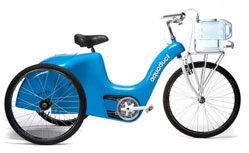Innovation, Social Innovation, and Helping Poverty

I’m so new to blogging that I just found out today (October 21) that October 15 was Blog Action Day 2008. Some 12,000 bloggers banded together to raise awareness about poverty. I’d like to make that number 12,001, albeit belatedly.
According to the blog, Get Fresh Minds, in their Blog Action Day contribution, “Innovating Against Poverty,” none of today’s hot (technological) innovations have done much at all to reduce global poverty. However, there are several social innovations:
Social innovations, as they’re called, are new ideas, strategies and products that create a better world. As the world becomes more and more connected, new social innovations are being created all the time. The fact is that people want to help others, and they’re looking for new ways to do that.
The blog goes on to list several great social innovations:
- Kiva, a micro-lending organization that will support entrepreneurs in developing countries for as little as $25.
- Cheerful Givers, which provides birthday gift bags for children who are homeless or living in poverty
- The Hunger Site, which allows users to click daily and food will be donated by sponsors to food banks. The Hunger Site, by the way, just wants you to click the button; their sponsors provide the food!
- One Laptop Per Child, which provides laptops to children in developing countries.
To this list, I should add some organizations that we at Barnes & Conti particularly like:
- Heifer International, which gives livestock to people in impoverished communities, and gives recipients the training to best use the livestock.
- Habitat for Humanity, which relies on a crew of short-term volunteers to build ” simple, decent houses” for needy families all over the globe.
To this list, Get Fresh Minds adds one “gadget,” a truly innovative bicycle-like conveyance called the Aquaduct. The Aquaduct, “is a pedal-powered concept vehicle that transports, filters, and stores water. It is designed to address water sanitation and transportation in the developing world.” You fill the tank with water, pedal the vehicle home, and—while pedaling—the vehicle filters the water, making it safe for drinking. (In developing countries, people have to carry water an average of 4 miles from its source back to their homes.)
The Aquaduct, by the way, was designed by IDEO, a design consultancy that is almost synonymous with innovation. I’d personally love to explore IDEO’s innovation process in future blog postings.
But getting back to poverty, Get Fresh Minds concludes by saying, “Creating something that truly makes the world a better place is the best kind of innovation.” At Barnes & Conti, where one of our mottos is “work hard, have fun, and do good,” we’re more than inclined to agree.
—Joel Kleinbaum, Blogger-in-Cheif
P.S. For more information about the Aquaduct, including a demonstration, check out this link from Buzzfeed.

I also like the Grameen Bank among other microfinancing organizations.